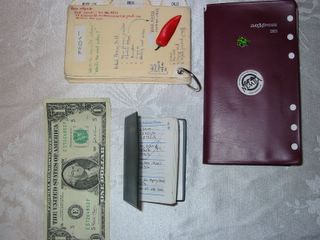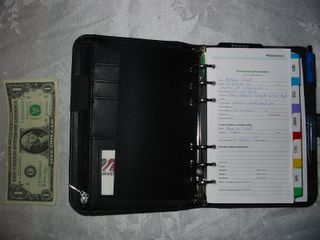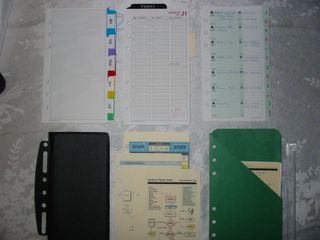Saturday
Aug272005
Fare thee well Hipster PDA - I barely knew ye
 Saturday, August 27, 2005 at 5:07PM
Saturday, August 27, 2005 at 5:07PM (from Shallow Brown)
I've put me clothes in order
For our packet leaves tomorrow
Yes, our packet leaves tomorrow
And it fills me heart with sorrow
For I love to gaze upon you
And to spend me money on you
O you are me only treasure
And I love ye still full measure
Well, after giving the Hipster Parietal Disgorgement Aid (hPDA) a solid two months of trial and tinkering, I've converted over to a paper planner. In this post I'll talk about why I changed (with pictures!), what planner I chose, how I've organized it, and how it's worked so far. (Apparently I'm not the only one who uses a paper planner for GTD, but of course there's always a variety.)
Why I changed
This first picture shows what I've been (until now) carrying around - my hPDA (at the top with the chili sticker), my two-page-per-week calendar (at the right with the red cover), and my little address book (bottom center, to the right of the scale indication artifact):

hPDA-based system
As you can imagine, I had to switch frequently between the three (esp. the first two), during my day, and I was getting tired of it. After looking around and doing a fairly detailed search (including some I hadn't heard of) I decided I liked the integrated (but still analog) solution a ring binder can provide. Additionally, I'm considering coaching GTD, and I wanted something that was simpler and looked a bit more polished.
What I chose
After looking on-line and locally I agonized a bit about what to buy, including the page size (I chose 3 3/4" x 6 3/4" pages), ring size (I chose 1" rings), and binder (zip, slip, snap, or open - sounds like a breakfast cereal ad). I finally decided on the Day-Timer Avalon, a basic but fairly compact starter set with undated pages. The following two pictures show it closed and open:

paper planner-based system

paper planner-based system
How I've organized it
I'm essentially using David Allen's instructions on how to set up a paper planner. The following picture shows the main sections:

paper planner contents
The top three are the main ones that I integrated from my previous system (GTD, calendar, and contacts, from left to right). The bottom three are "support" that I've found handy (checkbook holder, GTD diagrams for coaching, and misc. collection/carrying pockets, from left to right). (The contents are a mixture of products from Day-Timer and Day Runner.) The GTD tabs are straight from my hPDA: Inbox, Food Diary, Errand, Calls, Home, Waiting For & Agenda, Computer, Check Register, Projects, and Blank.
How it's worked so far
So far I'm very happy with the switch. Finding the right section, and retrieving/adding information is much faster, and I like the compact/clean feel of the whole package. For the future, I'm evaluating the vertical calendar (my previous was horizontal), and considering adding top tabs for the three main sections (the included "Today" marker/ruler works great for the calendar section).
I'd be curious to hear from others that have moved in either direction: hPDA->paper planner, and vice versa. Take care!

